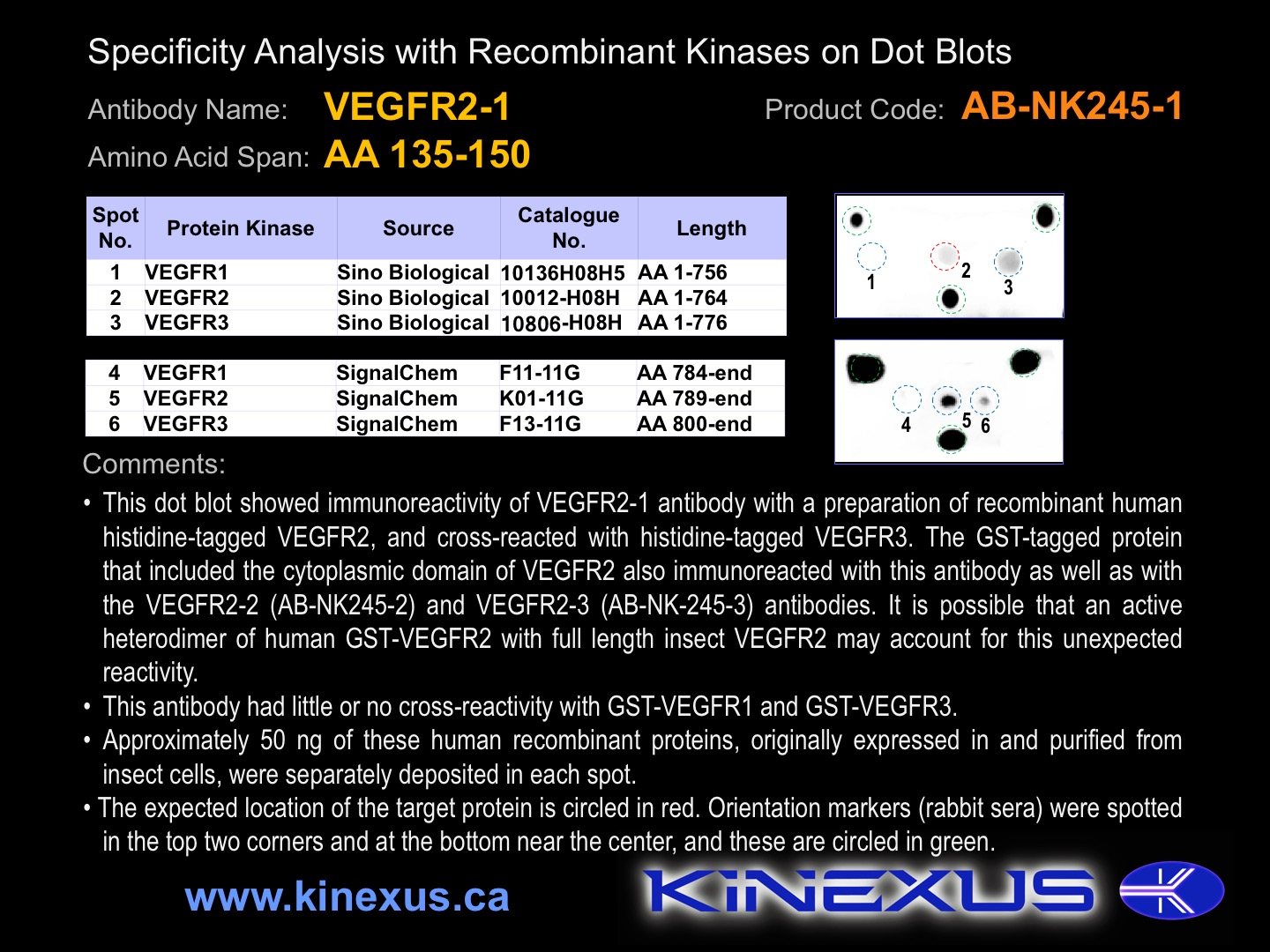Product Name: VEGFR2-1
Product Number: AB-NK245-1
| Size: | 25 µg | Price: | 89.00 | |
| $US |
Target Full Name: Vascular endothelial growth factor receptor 2 ; Vascular endothelial growth factor receptor-tyrosine kinase 2 (Flk1)
Target Alias: A type III receptor tyrosine kinase; CD309; FLK1; Kinase insert domain receptor; Protein-tyrosine kinase receptor Flk-1; Vascular endothelial growth factor receptor 2; VEGFR; VEGFR2; VGR2; CD309; CCDS3497.1; ENSG00000128052
Product Type Specific: Protein kinase pan-specific antibody
Antibody Code: NK245-1
Antibody Target Type: Pan-specific
Protein UniProt: P35968
Protein SigNET: P35968
Antibody Type: Polyclonal
Antibody Host Species: Rabbit
Target Alias: A type III receptor tyrosine kinase; CD309; FLK1; Kinase insert domain receptor; Protein-tyrosine kinase receptor Flk-1; Vascular endothelial growth factor receptor 2; VEGFR; VEGFR2; VGR2; CD309; CCDS3497.1; ENSG00000128052
Product Type Specific: Protein kinase pan-specific antibody
Antibody Code: NK245-1
Antibody Target Type: Pan-specific
Protein UniProt: P35968
Protein SigNET: P35968
Antibody Type: Polyclonal
Antibody Host Species: Rabbit
Antibody Immunogen Source: Human VEGFR2 (KDR) sequence peptide Cat. No.: PE-01AVM95
Antibody Immunogen Sequence: VVYITENKNKTVVIPC
Antibody Immunogen Description: Corresponds to amino acid residues V135 to C150; In the extracellular domain of the receptor.
Antibody Immunogen Sequence: VVYITENKNKTVVIPC
Antibody Immunogen Description: Corresponds to amino acid residues V135 to C150; In the extracellular domain of the receptor.
Production Method: The immunizing peptide was produced by solid phase synthesis on a multipep peptide synthesizer and purified by reverse-phase hplc chromatography. Purity was assessed by analytical hplc and the amino acid sequence confirmed by mass spectrometry analysis. This peptide was coupled to KLH prior to immunization into rabbits. New Zealand White rabbits were subcutaneously injected with KLH-coupled immunizing peptide every 4 weeks for 4 months. The sera from these animals was applied onto an agarose column to which the immunogen peptide was thio-linked. Antibody was eluted from the column with 0.1 M glycine, pH 2.5. Subsequently, the antibody solution was neutralized to pH 7.0 with saturated Tris.
Antibody Modification: Unconjugated. Contact KInexus if you are interest in having the antibody biotinylated or coupled with fluorescent dyes.
Antibody Concentration: 0.75 mg/ml
Antibody Modification: Unconjugated. Contact KInexus if you are interest in having the antibody biotinylated or coupled with fluorescent dyes.
Antibody Concentration: 0.75 mg/ml
Storage Buffer: Phosphate buffered saline pH 7.4, 0.05% Thimerasol
Storage Conditions: For long term storage, keep frozen at -40°C or lower. Stock solution can be kept at +4°C for more than 3 months. Avoid repeated freeze-thaw cycles.
Product Use: Western blotting | Antibody microarray
Antibody Dilution Recommended: 2 µg/ml for immunoblotting
Antibody Species Reactivity: Human; Mouse
Antibody Positive Control: The observed molecular mass of the processed target protein on SDS-PAGE gels is reported to be around 170-200 kDa.
Antibody Specificity: Medium
Storage Conditions: For long term storage, keep frozen at -40°C or lower. Stock solution can be kept at +4°C for more than 3 months. Avoid repeated freeze-thaw cycles.
Product Use: Western blotting | Antibody microarray
Antibody Dilution Recommended: 2 µg/ml for immunoblotting
Antibody Species Reactivity: Human; Mouse
Antibody Positive Control: The observed molecular mass of the processed target protein on SDS-PAGE gels is reported to be around 170-200 kDa.
Antibody Specificity: Medium
Antibody Cross Reactivity: Very weak immunoreactivity on protein dot blots with recombinant human VGFR3. No immunoreactivity on protein dot blots with recombinant human VGFR1.
Related Product 1: VEGFR2-1 blocking peptide
Related Product 2: VEGFR2-2 pan-specific antibody (Cat. No.: AB-NK245-2)
Related Product 3: VEGFR2-3 pan-specific antibody (Cat. No.: AB-NK245-3)
Related Product 4: VEGFR2-pY1054 phosphosite-specific antibody (Cat. No.: AB-PK852)
Related Product 1: VEGFR2-1 blocking peptide
Related Product 2: VEGFR2-2 pan-specific antibody (Cat. No.: AB-NK245-2)
Related Product 3: VEGFR2-3 pan-specific antibody (Cat. No.: AB-NK245-3)
Related Product 4: VEGFR2-pY1054 phosphosite-specific antibody (Cat. No.: AB-PK852)
Scientific Background: VEGFR2 (KDR, FLK1) is a protein-tyrosine kinase of the TK group and VEGFR (vascular endothelial growth factor receptor) family. It is a receptor kinase that binds VEGFA, VEGFC, and VEGFD, and has an essential function in the regulation of angiogenesis, vascular development, vascular permeability, and embryonic hematopoiesis. VEGFR2 activation promotes the proliferation, survival, migration, and differentiation of endothelial cells. It is activated by binding VEGF, which induces dimerization and autophosphorylation at the following phosphosites, which all contribute to increased phosphotransferase activity. In addition, autophosphorylation of Y801 induces interaction with PIK3R1, autophosphorylation of Y951 and Y1008 induces interaction with PLCg1, autophosphorylation of Y1054, Y996 and Y1059 induces interaction with PLCg1, and autophosphorylation of Y1175 induces interaction with PLCg1, Shb, Shc1 and Shc2. KDR mediates the activation of the ERK1/2 MAP kinase intracellular signalling pathways. VEGFR2 appears to be an oncoprotein (OP). Mutations in the VEGFR2 gene have been observed in patients with hemangioma. Significantly higher VEGFR2 expression was observed in metastatic as compared to non-metastatic human colon cancer cell lines, which directly correlated with increased neovascularization and tumour cell proliferation. Elevated VEGFR2 expression was also correlated with blood vessel count in human intestinal-type gastric cancers, and in tumour cells in primary and metastatic ovarian carcinomas. VEGF signalling is vital to the early stages of tumour progression in mouse models of squamous skin tumours. In addition, inhibition of VEGFR2 resulted in tumour regression through decreased microvasculature and impaired ability to maintain the stem-like characteristic of the tumour cells.
© Kinexus Bioinformatics Corporation 2017


